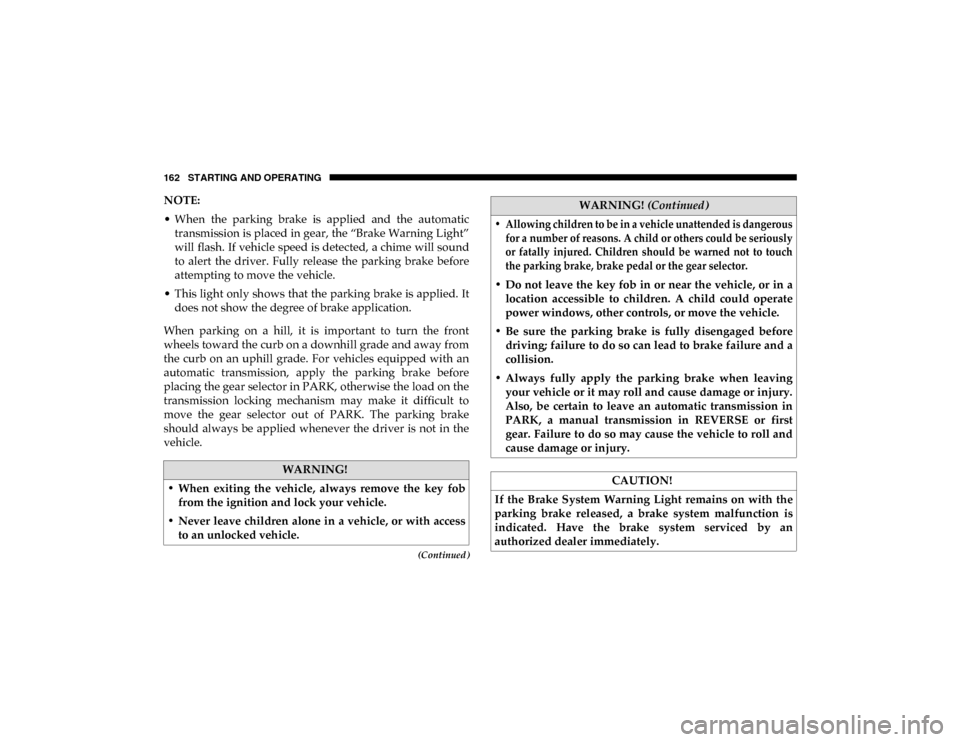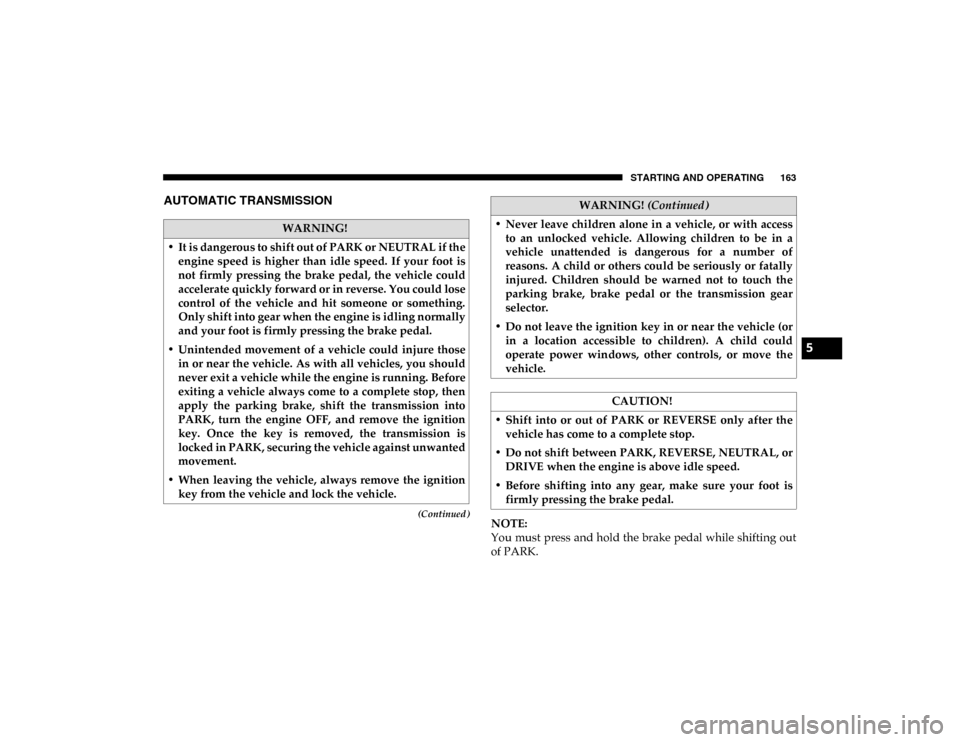automatic transmission Ram ProMaster City 2020 Owner's Manual
[x] Cancel search | Manufacturer: RAM, Model Year: 2020, Model line: ProMaster City, Model: Ram ProMaster City 2020Pages: 350, PDF Size: 13.27 MB
Page 7 of 350

4
WARNING LIGHTS AND MESSAGES .......................... 84
Red Warning Lights ...................................................... 84
Yellow Warning Lights................................................. 88
Green Indicator Lights .................................................. 92
Blue Indicator Lights ..................................................... 93
ONBOARD DIAGNOSTIC SYSTEM — OBD II ............. 94
Onboard Diagnostic System (OBD II)
Cybersecurity ................................................................. 94
EMISSIONS INSPECTION AND MAINTENANCE
PROGRAMS ....................................................................... 95
SAFETY
SAFETY FEATURES ........................................................... 97
Four-Wheel Anti-Lock Brake System (ABS) ............ 97
Electronic Brake Control (EBC) System .................... 98
AUXILIARY DRIVING SYSTEMS .................................. 103
Tire Pressure Monitoring System (TPMS) ............. 103
OCCUPANT RESTRAINT SYSTEMS ........................... 108
Occupant Restraint Systems ...................................... 108
Important Safety Precautions .................................... 108
Seat Belt Systems ........................................................ 109
Supplemental Restraint Systems (SRS) .................... 120
Child Restraints ......................................................... 133
Transporting Pets ..................................................... 153
SAFETY TIPS ...................................................................153
Transporting Passengers ............................................153
Exhaust Gas ..............................................................153
Safety Checks You Should Make Inside
The Vehicle ..................................................................154
Periodic Safety Checks You Should Make Outside
The Vehicle ...................................................................156
STARTING AND OPERATING
STARTING THE ENGINE ..............................................157
Automatic Transmission.............................................157
Normal Starting ........................................................... 157
Cold Weather Operation ...........................................158
Extended Park Starting ...............................................158
If Engine Fails To Start ..............................................158
After Starting ................................................................159
ENGINE BLOCK HEATER — IF EQUIPPED .............159
ENGINE BREAK-IN RECOMMENDATIONS ............160
PARKING BRAKE ........................................................... 161
AUTOMATIC TRANSMISSION ....................................163
Key Ignition Park Interlock ........................................164
Brake/Transmission Shift Interlock System ............164
Nine-Speed Automatic Transmission ......................164
2020_RAM_PROMASTER_CITY_OM_USA=GUID-7B6A7FCA-79B0-423F-95C5-ED2A949C3D13=1=en=.book Page 4
Page 8 of 350

5
POWER STEERING ......................................................... 171
Power Steering Fluid Check ...................................... 171
SPEED CONTROL — IF EQUIPPED ............................. 172
To Activate ................................................................... 172
To Set A Desired Speed .............................................. 173
To Vary The Speed Setting ......................................... 173
To Accelerate For Passing .......................................... 174
To Resume Speed ........................................................ 175
To Deactivate ............................................................... 175
PARKSENSE REAR PARK ASSIST —
IF EQUIPPED ................................................................... 175
ParkSense Rear Park Assist Sensors ......................... 176
ParkSense Rear Park Assist Alerts ............................ 176
ParkSense Rear Park Assist Failure Indications...... 177
Cleaning The ParkSense Rear Park Assist
System ........................................................................... 178
ParkSense Rear Park Assist System Usage
Precautions ................................................................... 178
PARKVIEW REAR BACK UP CAMERA ..................... 179
REFUELING THE VEHICLE .......................................... 181
VEHICLE LOADING ......................................................182
Vehicle Certification Label .......................................182
Gross Vehicle Weight Rating (GVWR) ...................183
Gross Axle Weight Rating (GAWR) .........................183
Tire Size .........................................................................183
Rim Size.........................................................................183
Inflation Pressure .........................................................183
Curb Weight .................................................................183
Overloading ..................................................................183
Loading ......................................................................184
TRAILER TOWING ........................................................184
Common Towing Definitions ....................................184
Trailer Hitch Classification.........................................187
Trailer Towing Weights (Maximum Trailer
Weight Ratings) .........................................................188
Trailer And Tongue Weight ......................................188
Towing Requirements ................................................189
Towing Tips .................................................................193
RECREATIONAL TOWING
(BEHIND MOTORHOME, ETC.) ...................................195
Towing This Vehicle Behind Another Vehicle ...... 195
Recreational Towing — Automatic Transmission ...... 195
2020_RAM_PROMASTER_CITY_OM_USA=GUID-7B6A7FCA-79B0-423F-95C5-ED2A949C3D13=1=en=.book Page 5
Page 10 of 350

7
DEALER SERVICE ........................................................... 248
Engine Oil ................................................................... 248
Engine Oil Filter ......................................................... 250
Engine Air Cleaner Filter ......................................... 250
Air Conditioner Maintenance ................................. 251
Body Lubrication ....................................................... 252
Windshield Wiper Blades ......................................... 252
Exhaust System ........................................................... 253
Cooling System .......................................................... 255
Brake System ............................................................... 260
Power Steering Fluid................................................... 261
Automatic Transmission ........................................... 261
Upfitter Connectors — If Equipped.......................... 263
RAISING THE VEHICLE ............................................... 266
TIRES................................................................................... 266
Tire Safety Information ............................................ 266
Tires — General Information .................................... 276
Tire Types ..................................................................... 282
Spare Tires — If Equipped ....................................... 283
Wheel And Wheel Trim Care ................................. 285
Tire Chains (Traction Devices) ................................. 287
Tire Rotation Recommendations ............................... 287
DEPARTMENT OF TRANSPORTATION UNIFORM
TIRE QUALITY GRADES ...............................................288
Treadwear .....................................................................288
Traction Grades............................................................ 289
Temperature Grades ................................................... 289
STORING THE VEHICLE .............................................289
BODYWORK ......................................................................290
Protection From Atmospheric Agents ....................290
Body And Underbody Maintenance .........................290
Preserving The Bodywork .......................................... 291
INTERIORS .......................................................................292
Seats And Fabric Parts ................................................292
Plastic And Coated Parts ............................................292
Leather Parts.................................................................293
Glass Surfaces ..............................................................293
2020_RAM_PROMASTER_CITY_OM_USA=GUID-7B6A7FCA-79B0-423F-95C5-ED2A949C3D13=1=en=.book Page 7
Page 94 of 350

GETTING TO KNOW YOUR INSTRUMENT PANEL 91
Engine Check/Malfunction Indicator Warning Light (MIL)
The Engine Check/Malfunction Indicator Light
(MIL) is a part of an Onboard Diagnostic System
called OBD II that monitors engine and automatic
transmission control systems. This warning light will illu -
minate when the ignition is in the ON/RUN position before
engine start. After placing the ignition to the ON/RUN
position, if there is a problem with the Sentry Key System,
the Vehicle Security Light will turn on. This condition will
result in the engine being shut off after two seconds. If the
bulb does not come on when turning the ignition switch
from OFF to ON/RUN, have the condition checked
promptly.
NOTE:
This warning light will illuminate when the vehicle security
alarm system has detected an attempt to break into the
vehicle.
Certain conditions, such as a loose or missing gas cap, poor
quality fuel, etc., may illuminate the light after engine start.
The vehicle should be serviced if the light stays on through
several typical driving styles. In most situations, the vehicle
will drive normally and will not require towing. When the engine is running, the MIL may flash to alert
serious conditions that could lead to immediate loss of
power or severe catalytic converter damage. The vehicle
should be serviced by an authorized dealer as soon as
possible if this occurs.
WARNING!
A malfunctioning catalytic converter, as referenced
above, can reach higher temperatures than in normal
operating conditions. This can cause a fire if you drive
slowly or park over flammable substances such as dry
plants, wood, cardboard, etc. This could result in death
or serious injury to the driver, occupants or others.
CAUTION!
Prolonged driving with the Malfunction Indicator Light
(MIL) on could cause damage to the vehicle control
system. It also could affect fuel economy and
driveability. If the MIL is flashing, severe catalytic
converter damage and power loss will soon occur.
Immediate service is required.3
2020_RAM_PROMASTER_CITY_OM_USA=GUID-7B6A7FCA-79B0-423F-95C5-ED2A949C3D13=1=en=.book Page 91
Page 134 of 350

SAFETY 131
Enhanced Accident Response System
In the event of an impact, if the communication network
remains intact, and the power remains intact, depending on
the nature of the event, the ORC will determine whether to
have the Enhanced Accident Response System perform the
following functions:
• Cut off fuel to the engine (if equipped)
• Cut off battery power to the electric motor (if equipped)
• Flash hazard lights as long as the battery has power
• Turn on the interior lights, which remain on as long as thebattery has power or for 15 minutes from the intervention
of the Enhanced Accident Response System
• Unlock the power door locks
Your vehicle may also be designed to perform any of these
other functions in response to the Enhanced Accident
Response System:
• Turn off the Fuel Filter Heater, Turn off the HVAC Blower Motor, Close the HVAC Circulation Door • Cut off battery power to the:
• Engine
• Electric Motor (if equipped)
• Electric Power Steering
• Brake booster
• Automatic transmission gear selector
• Horn
• Front wiper
NOTE:
After an accident, remember to cycle the ignition to the STOP
(OFF/LOCK) position and remove the key from the ignition
switch to avoid draining the battery. Carefully check the
vehicle for fuel leaks in the engine compartment and on the
ground near the engine compartment and fuel tank before
resetting the system and starting the engine. If there are no
fuel leaks or damage to the vehicle electrical devices (e.g.
headlights) after an accident, reset the system by following
the procedure described below. If you have any doubt,
contact an authorized dealer.
4
2020_RAM_PROMASTER_CITY_OM_USA=GUID-7B6A7FCA-79B0-423F-95C5-ED2A949C3D13=1=en=.book Page 131
Page 160 of 350

157
STARTING AND OPERATING
STARTING THE ENGINE
Before starting your vehicle, adjust your seat, adjust both
inside and outside mirrors, and fasten your seat belts.
Automatic Transmission
The gear selector must be in the PARK (P) or NEUTRAL (N)
position before you can start the engine. Press the brake
pedal before shifting to any driving gear.
NOTE:
You must press the brake pedal before shifting out of PARK.
Normal Starting
NOTE:
Normal starting of either a cold or a warm engine is obtained
without pumping or pressing the accelerator pedal.
Turn the ignition switch to the AVV (START) position and
release it when the engine starts. If the engine fails to start
within 10 seconds, turn the ignition switch to the STOP
(OFF/LOCK) position, wait 10 to 15 seconds, then repeat the
“Normal Starting” procedure.
WARNING!
• Never leave children alone in a vehicle, or with access to an unlocked vehicle.
• Allowing children to be in a vehicle unattended is dangerous for a number of reasons. A child or others
could be seriously or fatally injured. Children should
be warned not to touch the parking brake, brake pedal
or the transmission gear selector.
• Do not leave the key fob in or near the vehicle (or in a location accessible to children). A child could operate
power windows, other controls, or move the vehicle.
5
2020_RAM_PROMASTER_CITY_OM_USA=GUID-7B6A7FCA-79B0-423F-95C5-ED2A949C3D13=1=en=.book Page 157
Page 162 of 350

STARTING AND OPERATING 159
After Starting
The idle speed is controlled automatically, and it will
decrease as the engine warms up.
ENGINE BLOCK HEATER — IF EQUIPPED
The engine block heater warms the engine and permits
quicker starts in cold weather.
Connect the cord to a 110-115 Volt AC electrical outlet with a
grounded, three-wire extension cord.
For ambient temperatures below 0°F (-18°C), the engine
block heater is recommended. For ambient temperatures
below -20°F (-29°C), the engine block heater is required.
The engine block heater cord is routed under the hood,
behind to the driver’s side headlamp. Follow the steps below
to properly use the engine block heater:
1. Locate the engine block heater cord (behind the driver’sside headlamp).
2. Undo the hook-and-loop strap that secures the heater cord in place.
WARNING!
• Never pour fuel or other flammable liquid into the throttle body air inlet opening in an attempt to start the
vehicle. This could result in flash fire causing serious
personal injury.
• Do not attempt to push or tow your vehicle to get it started. Vehicles equipped with an automatic
transmission cannot be started this way. Unburned fuel
could enter the catalytic converter and once the engine
has started, ignite and damage the converter and
vehicle.
• If the vehicle has a discharged battery, booster cables may be used to obtain a start from a booster battery or
the battery in another vehicle. This type of start can be
dangerous if done improperly. Refer to “Jump Starting
Procedure” in “In Case Of Emergency” for further
information.
CAUTION!
To prevent damage to the starter, do not continuously
crank the engine for more than 25 seconds at a time. Wait
60 seconds before trying again.
5
2020_RAM_PROMASTER_CITY_OM_USA=GUID-7B6A7FCA-79B0-423F-95C5-ED2A949C3D13=1=en=.book Page 159
Page 164 of 350

STARTING AND OPERATING 161
NOTE:
A new engine may consume some oil during its first few
thousand miles (kilometers) of operation. This should be
considered a normal part of the break-in and not interpreted
as a problem. Please check your oil level with the engine oil
indicator often during the break in period. Add oil as
required.
PARKING BRAKE
Before leaving the vehicle, make sure that the parking brake
is fully applied. Also, be certain to leave an automatic trans-
mission in PARK, or manual transmission in REVERSE or
first gear.
The parking brake lever is located in the center console. To
apply the parking brake, pull the lever up as firmly as
possible. To release the parking brake, pull the lever up
slightly, press the center button, then lower the lever
completely. Parking Brake
When the parking brake is applied with the ignition switch
in the ON position, the “Brake Warning Light” in the instru-
ment cluster will illuminate.
5
2020_RAM_PROMASTER_CITY_OM_USA=GUID-7B6A7FCA-79B0-423F-95C5-ED2A949C3D13=1=en=.book Page 161
Page 165 of 350

162 STARTING AND OPERATING
(Continued)
NOTE:
• When the parking brake is applied and the automatictransmission is placed in gear, the “Brake Warning Light”
will flash. If vehicle speed is detected, a chime will sound
to alert the driver. Fully release the parking brake before
attempting to move the vehicle.
• This light only shows that the parking brake is applied. It does not show the degree of brake application.
When parking on a hill, it is important to turn the front
wheels toward the curb on a downhill grade and away from
the curb on an uphill grade. For vehicles equipped with an
automatic transmission, apply the parking brake before
placing the gear selector in PARK, otherwise the load on the
transmission locking mechanism may make it difficult to
move the gear selector out of PARK. The parking brake
should always be applied whenever the driver is not in the
vehicle.
WARNING!
• When exiting the vehicle, always remove the key fob from the ignition and lock your vehicle.
• Never leave children alone in a vehicle, or with access to an unlocked vehicle.
• Allowing children to be in a vehicle unattended is dangerousfor a number of reasons. A child or others could be seriously
or fatally injured. Children should be warned not to touch
the parking brake, brake pedal or the gear selector.
• Do not leave the key fob in or near the vehicle, or in a location accessible to children. A child could operate
power windows, other controls, or move the vehicle.
• Be sure the parking brake is fully disengaged before driving; failure to do so can lead to brake failure and a
collision.
• Always fully apply the parking brake when leaving your vehicle or it may roll and cause damage or injury.
Also, be certain to leave an automatic transmission in
PARK, a manual transmission in REVERSE or first
gear. Failure to do so may cause the vehicle to roll and
cause damage or injury.
CAUTION!
If the Brake System Warning Light remains on with the
parking brake released, a brake system malfunction is
indicated. Have the brake system serviced by an
authorized dealer immediately.
WARNING! (Continued)
2020_RAM_PROMASTER_CITY_OM_USA=GUID-7B6A7FCA-79B0-423F-95C5-ED2A949C3D13=1=en=.book Page 162
Page 166 of 350

STARTING AND OPERATING 163
(Continued)
AUTOMATIC TRANSMISSION
NOTE:
You must press and hold the brake pedal while shifting out
of PARK.
WARNING!
• It is dangerous to shift out of PARK or NEUTRAL if the engine speed is higher than idle speed. If your foot is
not firmly pressing the brake pedal, the vehicle could
accelerate quickly forward or in reverse. You could lose
control of the vehicle and hit someone or something.
Only shift into gear when the engine is idling normally
and your foot is firmly pressing the brake pedal.
• Unintended movement of a vehicle could injure those in or near the vehicle. As with all vehicles, you should
never exit a vehicle while the engine is running. Before
exiting a vehicle always come to a complete stop, then
apply the parking brake, shift the transmission into
PARK, turn the engine OFF, and remove the ignition
key. Once the key is removed, the transmission is
locked in PARK, securing the vehicle against unwanted
movement.
• When leaving the vehicle, always remove the ignition key from the vehicle and lock the vehicle.• Never leave children alone in a vehicle, or with accessto an unlocked vehicle. Allowing children to be in a
vehicle unattended is dangerous for a number of
reasons. A child or others could be seriously or fatally
injured. Children should be warned not to touch the
parking brake, brake pedal or the transmission gear
selector.
• Do not leave the ignition key in or near the vehicle (or in a location accessible to children). A child could
operate power windows, other controls, or move the
vehicle.
CAUTION!
• Shift into or out of PARK or REVERSE only after the vehicle has come to a complete stop.
• Do not shift between PARK, REVERSE, NEUTRAL, or DRIVE when the engine is above idle speed.
• Before shifting into any gear, make sure your foot is firmly pressing the brake pedal.
WARNING! (Continued)
5
2020_RAM_PROMASTER_CITY_OM_USA=GUID-7B6A7FCA-79B0-423F-95C5-ED2A949C3D13=1=en=.book Page 163